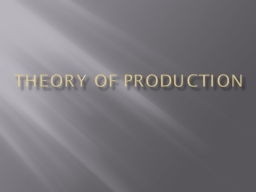

Main Ideas The production function is a graph or figure that shows how a change in one production variable affects total output Production can be analyzed in terms of shortrun or longrun relationships between inputs and outputs ID: 1028007
Download Presentation The PPT/PDF document "Theory Of Production The Production Func..." is the property of its rightful owner. Permission is granted to download and print the materials on this web site for personal, non-commercial use only, and to display it on your personal computer provided you do not modify the materials and that you retain all copyright notices contained in the materials. By downloading content from our website, you accept the terms of this agreement.
1. Theory Of Production
2. The Production Function (not conjunction junction!)Main IdeasThe production function is a graph or figure that shows how a change in one production variable affects total output.Production can be analyzed in terms of short-run or long-run relationships between inputs and outputs.Marginal product is the extra output or change in total product caused by adding one more unit of input.
3. Production FunctionProduction function: a graph or figure that shows how a change in one production variable affects total output.Look at figure 5.5 on page 137Why is the use of the production function important in business?It allows businesses to gauge whether additional input will result in extra output
4. Short RunShort Run: Only the amount of labor can change in production period.Ex: Hire or fire workers
5. Short RunWhy is a short-run production function useful for measuring effects of changes in labor?Output resulting from changes in labor can be evaluated using shorter periods, such as on a daily basis.Output resulting from changes in other variables, such as land or capital, requires longer periods of evaluation.
6. Long RunLong Run:All factors of production may be changed in production periodEx: Moving to a new building, changing owners
7. Total ProductTotal Product: Total Output or production by a firmAdd inputs total product goes upAdd too many inputs total product will go downSee Figure 5.5Just add all units produced for a given period of time
8. Marginal ProductMarginal Product:Extra output due to the addition of one more unit of input.Change in output/ Change in input
9. Stages of ProductionIn Stage I of the production function, the marginal product increases with each additional worker.Low productionStage II of the production function operates on the principle of diminishing returns; marginal products are still positive, but decrease steadily.Production grows and hit optimal levelIn Stage III of the production function, the company has hired too many workers, and they interfere with one another and with production, causing marginal product to become negative.Production falling
10. Diminishing ReturnsDiminishing Returns:Stage of production where output increases at a decreasing rate as more units of a variable input are added.
11. Finding Marginal CostsMain IdeasThe costs that an organization incurs even when there is little or no activity are fixed costs, or overhead.Variable costs are usually associated with labor and raw materials and change with the business’s rate of operation or output.Total cost is the sum of fixed and variable costs.Marginal cost is the extra cost incurred to produce one more unit of output.
12. Fixed CostsFixed Costs:Costs incurred just by owning a businessEx: Salaries, Rent, Taxes
13. Variable CostsVariable Costs:Costs that change due to operation or output changesEx: Laid off workers, raises, electricity, shipping
14. Total CostTotal Cost:Add variable and fixed cost together
15. Marginal CostMarginal CostExtra cost of producing one additional unit of productAdditional costs Additional output
16. ReviewWhat is the most useful measure of cost?marginal costWhat types of costs must businesses compute to find marginal cost?fixed costs, variable costs, and total costsWhat does marginal cost represent?the extra cost incurred when producing one more unit of output
17. Marginal RevenueMain IdeasAverage revenue is the average price of every unit of output.Total revenue is all of the revenue a business receives.Marginal revenue is the extra revenue a business receives from the production and sale of one additional unit of output.Marginal revenue is the most important measure of revenue.
18. Marginal RevenueMarginal revenue = change in total revenue change in total output
19. Scenario A leaf-raking business is considering hiring a new worker. The only cost to the business would be the worker's wage, which is $90 per day. The worker can rake four yards per day, and customers are charged a price of $20 per yard. Should the business hire the worker?No. The marginal cost to hire the worker—$90 in wages—would be higher than the marginal revenue the firm would earn—4 yards X $20 = $80.